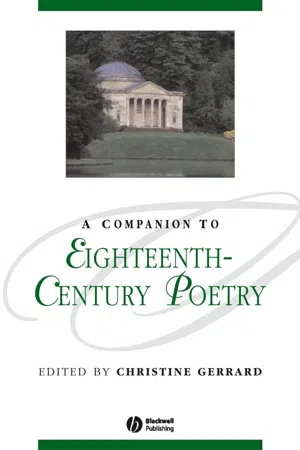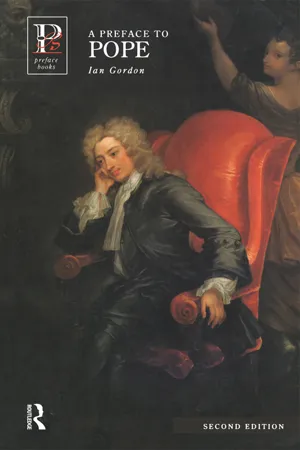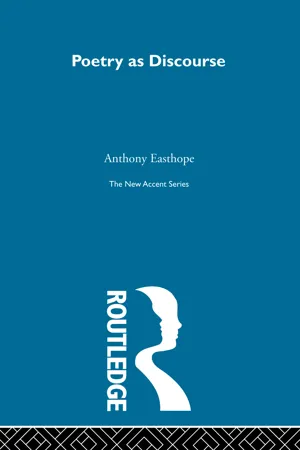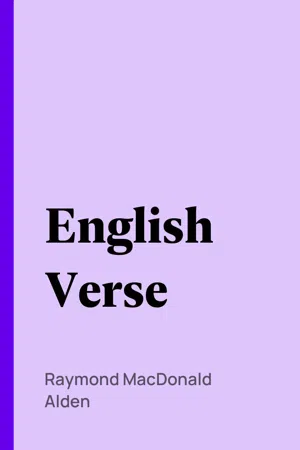Literature
Heroic Couplet
A heroic couplet is a pair of rhyming lines in iambic pentameter, commonly used in English poetry. Each couplet presents a complete thought or idea, making it a concise and impactful form of expression. This structure has been popular in literature for centuries, particularly in epic and narrative poetry, as well as in satirical and didactic works.
Written by Perlego with AI-assistance
5 Key excerpts on "Heroic Couplet"
- eBook - ePub
- Christine Gerrard, Christine Gerrard, Christine Gerrard(Authors)
- 2013(Publication Date)
- Wiley-Blackwell(Publisher)
Kames goes on to pronounce on such matters as the placing of the “capital pause” (caesura) which, except in rare moments of license and abandon, must occur at the fourth, fifth, sixth, or seventh syllables of the line to maintain balance and symmetry. Most significantly, he claims that the given, permissible range of options and variations available to the poet correspond predictably with such effects upon the reader as elevation, joy, depression, sadness, enervation, etc. (ii. 149–60).The Heroic Couplet dominated verse during the first two-thirds of the eighteenth century. Numerically, far more poems used it than any other form, with blank verse next, the octosyllabic couplet third, and the stanza taking up the rear (for detailed statistics see Havens 1922). It was ideally suited to the gradual shift in the status of poetry as it began to occupy generic territory that in other periods was the exclusive reserve of the essay or the newspaper article. Verse could directly engage with contemporary political issues (the field of the so-called “poem on affairs of state”) or, in the more discursive, “georgic” mode, could address a virtually unlimited range of subjects: thus architecture, dress sense, the sanitary conditions of the streets and the practical conventions of sheep husbandry all vied for the poet's attention. In this environment the closed, balanced couplet was valued because while it was self-evidently poetic – it attended to a given metrical and rhyming formula – its structural features and their effects were, as Kames and many others demonstrated, relatively predictable. It became like a subsidiary to rhetoric, enabling the poet to write in a way that gave due attention to the progressive, transparent logic of good prose.Those who transgressed this new system of conventions were widely rebuked. For example, throughout the eighteenth century practitioners of the enjambed couplet were treated as irresponsible eccentrics who were misusing a key element in the process of transference of sense from poet via text to reader: the line. There were certainly very few of them, the most notable being Isaac Watts (1674–1748) – a nonconformist preacher whose unorthodoxy in religion was mirrored in his use of off-rhymes and couplets resonant of Donne – and, later, Charles Churchill (1731–64). A satirical parody of Churchill's technique offers a fair reflection of the critical consensus. - eBook - ePub
The Princeton Encyclopedia of Poetry and Poetics
Fourth Edition
- Stephen Cushman, Clare Cavanagh, Jahan Ramazani, Paul Rouzer, Stephen Cushman, Clare Cavanagh, Jahan Ramazani, Paul Rouzer, Stephen Cushman, Clare Cavanagh, Jahan Ramazani, Paul Rouzer(Authors)
- 2012(Publication Date)
- Princeton University Press(Publisher)
Winters, “The Heroic Couplet and Its Recent Revivals,” In Defense of Reason (1943); W. C. Brown, The Triumph of Form (1948); W. K. Wimsatt, “One Relation of Rhyme to Reason,” The Verbal Icon (1954); J. H. Adler, The Reach of Art (1964); J. A. Jones, Pope’s Couplet Art (1969); W. B. Piper, The Heroic Couplet (1969); G. T. Amis, “The Structure of the Augustan Couplet,” Genre 9 (1976); H. Carruth, “Three Notes on the Versewriting of Alexander Pope,” Michigan Quarterly Review 15 (1976); An Heroic Couplet Anthology, ed. W. B. Piper (1977); Thompson; Brogan, 389 ff.; P. Deane, At Home in Time: Forms of Neo-Augustanism in Modern English Verse (1994); T. Steele, “‘The Bravest Sort of Verses’: The Heroic Couplet,” Finch and Varnes; D. Caplan, Questions of Possibility (2005), ch. 4. W. B. P IPER ; S. C USHMAN HEROIC VERSE, heroic meter, heroic poetry. The term came to be used for *epic in the Middle Ages and after. Isidore of Seville in his Etymologiae (7th c. CE) defines heroic poetry (carmen heroicum) as being so named “because in it the affairs and deeds of brave men are narrated (for heroes are spoken of as men practically supernatural and worthy of Heaven on account of their wisdom and bravery); and this meter precedes others in status.” In the Ren., Marco Girolamo Vida proclaims the subject of his De arte poetica (On Poetic Art, 1527) to be heroic poetry, though, in fact, it consists mainly of practical advice for poets derived from Horace and Quintilian. Torquato Tasso in his Discorsi del poema eroico (Discourses on the Heroic Poem, 1594) advocated a more romantic conception of epic but also insisted on accurate depiction of historical reality; he also wrote “heroic sonnets” celebrating great men and events of the past. John Dryden opens the Preface to his trans - eBook - ePub
- Ian Robert Fraser Gordon(Author)
- 2017(Publication Date)
- Routledge(Publisher)
Indeed, since each line is an iambic pentameter, its development is an integral part of the basic metrical tradition in English poetry. Chaucer had used the decasyllabic couplet in The Canterbury Tales, and two hundred years or so later John Donne had used it in his Satires. When he was still a young poet. Pope wrote 'modernizations' of parts of both these works as an exercise in developing his skill. But there is a crucial difference between Pope's couplets and those of Chaucer and Donne before him. Pope's poems are all written in the closed couplet form. This means that each couplet has a distinct element of self-enclosed completeness to it. This is not to say that each couplet is totally independent of those that surround it, but it does mean that there is a clear pause at the end of each line, and a more emphatic pause at the end of the second line. The open, or enjambed, couplet on the other hand, is one in which the meaning frequently flows across the line-end without any clear pause. It is so different in the expectations it creates in the reader, and in the demands that it makes on the writer, that it is easier to think of it as belonging to a separate tradition, though somewhat confusingly the open and closed couplets are frequently referred to under the same label of the Heroic Couplet. It was in the second half of the seventeenth century and first part of the eighteenth that the Heroic Couplet reached its greatest popularity and, in the poetry of Dryden and Pope, its peak of performance. After Pope's death the Heroic Couplet continued to flourish in the poetry of Johnson, Goldsmith, Cowper and Churchill in the eighteenth century, and in that of Crabbe and Byron in the early part of the nineteenth. The development of the Romantic sensibility, however, saw a diminution in its popularity - eBook - ePub
- Antony Easthope(Author)
- 2013(Publication Date)
- Routledge(Publisher)
1970 , pp. 182–3). His reply, that poets don’t always practice what they preach, solves nothing, and I shall try to give a better answer. It is one that cannot draw too much on the passage from Canto ii. When Leigh Hunt attacked the ‘monotony and uniformity’ of the Heroic Couplet in 1814, he took these lines as evidence of the ‘kind of sing-song’ he was against – the caesura often occurs in the same place and several lines repeat the standard variation of beginning with a stressed syllable. In citing Hunt’s view, Winifred Nowottny has argued that the metrical ‘monotonies of this passage’ are contrived as ‘a metrical equivalent to Belinda’s indifference’ (1972, p. 8). If this is so, then details of the metre here are a local effect, another aspect of the iconicity.The rhyme is there so that there can be Heroic Couplets, the couplet being the form of line organization in which all other aspects of the Augustan style are grounded. Like iambic pentameter and indeed like discourse itself, the couplet is determined in three ways at once: linguistically, ideologically, subjectively.The linguistic shape of the couplet can be considered first. In ‘high’ Augustan practice the couplet becomes even more closed than it was earlier. Dryden’s verse admits triplet rhymes, the occasional hexameter (or alexandrine) and frequent use of run-on lines, all of which are avoided in Pope. The line becomes end-stopped and with a firm caesura, for as Pope claims, ‘in any smooth English verse of ten syllables, there is naturally a Pause at the fourth, fifth, or sixth syllable’ (cited Tillotson 1962 , p. 117). The verse form therefore prescribes a very high degree of isomorphism between phonetic, syntactic and semantic elements. The line (and so intonation) coincides with: (1) the phonetic as represented by sound in the rhymes; (2) the syntax as closed at line ending and couplet ending, and dictated by caesura; (3) meaning, which generally is completed inside the two lines.The Heroic Couplet operates the same economy as pentameter but in a more extreme definition. On the one hand, the abstract pattern is more rigidly and uniformly prescribed, since there is the isomorphism of phonetic, syntactic and semantic elements. On the other hand, as Jakobson has noted, intonation is very important ‘in poems like “The Rape of the Lock”’ (1960 , p. 365). The couplet promotes a peculiarly Augustan intonation in the way the second line completes and answers the first. A high tonal rise on the first rhyme word corresponds to a low fall on the second, giving the ‘sing-song’ of which Leigh Hunt complained. This breadth of tonal contrast, typically greater than in un-rhymed iambic pentameter, provides for a greater and more discriminated range of tone. There is the same counterpoint effect of pentameter but in a more contrasted economy, a greater rigidity of pattern together with - eBook - ePub
English Verse
Specimens Illustrating its Principles and History
- Raymond MacDonald Alden(Author)
- 2010(Publication Date)
- Perlego(Publisher)
The Deserted Village. 1770.)"The Heroic Couplet," says Mr. Gosse, "was never employed, even by Pope himself, with more melody than by Goldsmith in this poem." (Eighteenth Century Literature, p. 320.) Its use at this time, when the revival of blank verse by Thomson and others had seriously affected the prestige of the couplet, was a sign of Goldsmith's reactionary tendency toward the school of Pope. His dislike of blank verse he expressed in his early work on the Present State of Polite Learning, saying that it might be reckoned among "several disagreeable instances of pedantry" lately proceeding "from a desire in the critic of grafting the spirit of ancient languages upon the English." (Works, Globe ed., p. 439.) This opinion was of course shared by Goldsmith's friend, Dr. Johnson, whose two important poems (London and The Vanity of Human Wishes) stand with the two of Goldsmith as the last notable pieces of English poetry of the classical school. While Johnson admitted that he could not "wish that Milton had been a rhymer," yet he never lost an opportunity to speak contemptuously of blank verse as a poetic form, and quoted approvingly the saying of a critic that it "seems to be verse only to the eye." (Life of Milton.)In front of these came Addison. In him
Index pages curate the most relevant extracts from our library of academic textbooks. They’ve been created using an in-house natural language model (NLM), each adding context and meaning to key research topics.
Explore more topic indexes
Explore more topic indexes
1 of 6
Explore more topic indexes
1 of 4




